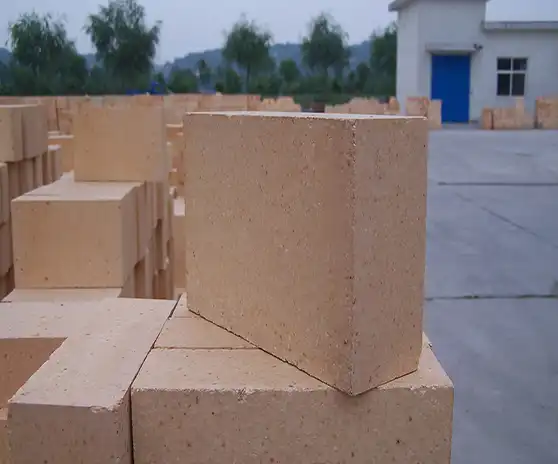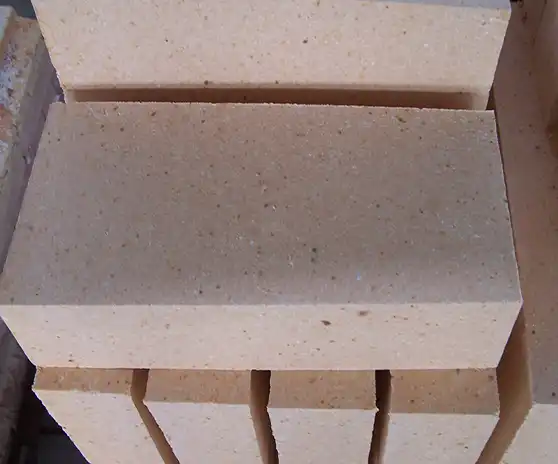

What materials are used in manufacturing BF High Alumina Bricks?
2025-04-27 13:07:57
BF High Alumina Bricks are sophisticated refractory products primarily manufactured using high-grade bauxite as the principal raw material. These specialized bricks contain aluminum oxide (Al₂O₃) content of 75% or higher, which contributes to their exceptional thermal resistance and mechanical properties. The manufacturing process incorporates premium quality calcined bauxite, along with carefully selected binding agents and additives that enhance the brick's performance characteristics. At TianYu Refractory, we've refined our material selection process over decades to ensure our BF High Alumina Brick products deliver superior performance in the demanding environments of blast furnaces and steel production facilities. The precise composition and material ratios used in our manufacturing process result in refractory products that consistently exceed industry standards for thermal shock resistance, low high-temperature creep, and slag erosion resistance.

Core Materials and Their Contribution to BF High Alumina Brick Performance
High-Grade Bauxite: The Foundation of Premium Refractory Bricks
High-grade bauxite serves as the primary raw material in manufacturing superior BF High Alumina Brick products. This naturally occurring mineral is rich in aluminum hydroxide minerals, which convert to aluminum oxide (Al₂O₃) during the calcination process. At TianYu Refractory, we meticulously select bauxite sources with minimal impurities, particularly those with low iron and silica content, as these elements can compromise the refractory properties of the final product. The quality of bauxite directly influences the brick's refractoriness, which in our products reaches or exceeds 1790°C. This exceptional heat resistance makes our BF High Alumina Brick ideal for the extreme temperatures experienced in blast furnaces. The bauxite undergoes rigorous quality testing in our state-of-the-art laboratory facilities, where we confirm its chemical composition and physical properties before it enters our production process. With over 20 years of experience in refractory manufacturing, we've established reliable sourcing relationships that ensure consistent raw material quality, which translates to predictable and reliable performance in our customers' operations. The high alumina content derived from premium bauxite contributes significantly to the brick's exceptional mechanical strength, with cold crushing strength values exceeding 60 MPa.
Binding Agents and Their Role in Structural Integrity
The binding agents used in BF High Alumina Brick manufacturing play a crucial role in determining the final product's structural integrity and performance characteristics. At TianYu Refractory, we employ a proprietary blend of ceramic binding agents that form strong chemical bonds during the firing process, resulting in a dense, cohesive microstructure that achieves bulk density values of 2.5 g/cm³ or higher. These carefully formulated binders contribute significantly to the brick's impressive cold crushing strength of ≥60 MPa and low apparent porosity of ≤22%. Our R&D center, recognized by Henan Province as an Engineering Technology R&D Center, continually refines our binding agent formulations to optimize the balance between mechanical strength and thermal shock resistance. The binding system must perform reliably through repeated thermal cycles, maintaining structural stability while accommodating the expansion and contraction that occurs during furnace operation. Our advanced binding technology contributes to the excellent slag resistance properties of our BF High Alumina Brick products, protecting them from chemical attack in the aggressive environment of steel production. This specialized binding system has been developed through decades of research and practical application, representing just one of the areas covered by our 21+ patents in refractory technology. The result is a BF High Alumina Brick that maintains its integrity even after prolonged exposure to extreme temperatures and aggressive slags, extending operational life and reducing maintenance requirements.
Additives and Performance-Enhancing Components
Beyond the primary bauxite material and binding agents, TianYu Refractory incorporates specialized additives into our BF High Alumina Brick formulations to enhance specific performance characteristics crucial for blast furnace applications. These carefully selected additives modify the microstructure and thermal properties of the bricks, improving their resistance to thermal shock, slag penetration, and structural degradation under load. Silicon carbide may be added in precise quantities to improve thermal conductivity and abrasion resistance, while zirconium compounds enhance resistance to alkali attack in certain applications. Our laboratory team optimizes these additive packages for each specific application, ensuring that our BF High Alumina Brick products meet the unique demands of different zones within the blast furnace. Some formulations include microporous structures that improve insulation properties while maintaining mechanical strength, a technology developed through our company's innovation initiatives. The ISO 9001:2015 certified quality management system at TianYu Refractory ensures that these additives are incorporated with precision and consistency across production batches. Each component serves a specific purpose in the overall performance profile of our BF High Alumina Brick, whether improving thermal cycling behavior, enhancing chemical stability, or extending service life. This attention to detail in material selection and formulation is why steel manufacturers worldwide trust our refractory solutions for their most demanding applications, from blast furnace linings to hot-blast stoves and torpedo car installations.

Manufacturing Processes for High-Quality BF High Alumina Bricks
Raw Material Preparation and Quality Control Procedures
The journey to creating superior BF High Alumina Brick begins with meticulous raw material preparation and stringent quality control procedures. At TianYu Refractory, we implement a comprehensive testing regime for all incoming materials, particularly the high-grade bauxite that forms the foundation of our products. This testing includes X-ray fluorescence analysis to verify chemical composition, particle size distribution measurement, and physical property assessment. Once approved, the raw materials undergo a carefully orchestrated preparation process, including crushing, grinding, and classification to achieve the optimal particle size distribution. This distribution is critical for the final brick properties, as it influences both the packing density during formation and the microstructure after firing. Our preparation facilities employ advanced automation systems that ensure consistent material processing while our laboratory technicians regularly sample the prepared materials to verify they meet our exacting specifications. The quality control extends to all additives and binding agents, each subjected to its own battery of tests before integration into the production flow. This front-end quality assurance is fundamental to maintaining the exceptional performance characteristics of our BF High Alumina Brick products, including their superior thermal resistance up to 1790°C and mechanical strength exceeding 60 MPa. Our ISO-certified quality management system provides full traceability throughout this preparation phase, allowing us to track every batch of material from receipt to final product, a capability that underpins our confidence in offering extended performance warranties to repeat customers.
Forming Techniques and Their Impact on Brick Properties
The forming phase in BF High Alumina Brick production significantly influences the final product's performance characteristics and is an area where TianYu Refractory's expertise truly shines. We employ multiple forming techniques, selecting the most appropriate method based on the specific application requirements of each brick type. For particularly demanding blast furnace applications, we utilize hydraulic pressing with pressures exceeding 1,200 kg/cm² to achieve optimal particle consolidation and density. This high-pressure forming technique contributes directly to the exceptional bulk density (≥2.5 g/cm³) and low apparent porosity (≤22%) of our BF High Alumina Brick products. For complex shapes, such as those used in tuyere assemblies or tap-hole areas, we employ specialized molding techniques that ensure dimensional precision while maintaining the material's integrity. Our forming processes incorporate precise temperature and humidity control, as these environmental factors can significantly affect the behavior of the ceramic body during forming. Each formed brick undergoes dimensional inspection before proceeding to the drying phase, ensuring that the tight tolerances required for seamless installation are maintained. The forming techniques we've developed over our 38 years in the refractory industry represent a critical link in the production chain, translating raw material quality into exceptional finished products. This expertise in forming technology contributes directly to the outstanding mechanical strength and thermal shock resistance that characterize our BF High Alumina Brick offerings. Our customers benefit from this attention to detail through reduced installation times, more consistent performance, and extended service life in their blast furnace operations.
Firing Regimes and Final Product Characteristics
The firing process represents the culmination of TianYu Refractory's BF High Alumina Brick manufacturing expertise, where carefully prepared and formed materials undergo the transformative high-temperature treatment that establishes their final refractory properties. Our tunnel kilns, equipped with advanced temperature control systems, execute precise firing regimes that have been optimized through decades of experience and continuous research. These computer-controlled firing cycles typically reach temperatures of 1500-1600°C, held for specific durations to ensure complete ceramic bond formation and optimal crystalline development within the brick structure. The firing process is where the chemical reactions between the alumina-rich bauxite and various additives occur, forming new mineral phases that contribute to the exceptional performance of our BF High Alumina Brick products. Our firing technology achieves remarkable consistency across production runs, with temperature variations limited to ±5°C throughout the kiln's effective volume. This precision ensures uniform development of physical properties throughout each batch of bricks. After firing, each production batch undergoes comprehensive testing in our laboratory facilities, including verification of alumina content (≥75%), apparent porosity (≤22%), bulk density (≥2.5 g/cm³), cold crushing strength (≥60 MPa), and refractoriness (≥1790°C). This rigorous testing regime, conducted in accordance with international standards, confirms that our BF High Alumina Brick products meet or exceed all specified performance parameters before release to customers. The final products exhibit the exceptional thermal resistance, mechanical strength, and chemical stability that make them ideal for the demanding conditions of blast furnaces, hot-blast stoves, and other high-temperature applications in steel production facilities worldwide.
Applications and Performance of BF High Alumina Bricks in Industrial Settings
Critical Zones in Blast Furnaces Requiring High Alumina Bricks
BF High Alumina Brick products are strategically deployed in several critical zones within blast furnaces where their exceptional thermal and mechanical properties are most needed. The hearth region, where temperatures can reach 1500°C and molten iron collects, demands refractory materials with outstanding resistance to thermal cycling and chemical attack from slag and metal. TianYu Refractory's BF High Alumina Brick, with its alumina content exceeding 75% and exceptional resistance to slag erosion, provides extended service life in this challenging environment. The bosh area, where the furnace transitions from a cylindrical to conical shape and experiences intense abrasion from descending burden materials, benefits from our high alumina formulations that deliver superior mechanical strength (≥60 MPa) and abrasion resistance. Our specialized tuyere assemblies, incorporating precisely engineered BF High Alumina Brick components, withstand the extreme thermal gradients and mechanical stresses at the points where hot blast air enters the furnace. The stack lining, though exposed to lower temperatures, faces challenging conditions from ascending gases and descending raw materials, where our high alumina bricks provide reliable service through their excellent thermal shock resistance and structural stability. The tap-hole area, subjected to extreme thermal cycling and mechanical stress during tapping operations, represents another critical application for our high-performance BF High Alumina Brick products. With bulk density values of 2.5 g/cm³ or higher and apparent porosity below 22%, these specialized bricks resist penetration by molten metal and slag while maintaining structural integrity through repeated tapping cycles. Our technical team, available 24/7 to respond to customer needs, provides expert guidance on the optimal selection and placement of BF High Alumina Brick products for each specific zone within the blast furnace, ensuring maximum performance and operational life.
Performance Metrics and Service Life Expectations
The exceptional performance of TianYu Refractory's BF High Alumina Brick products in industrial applications is quantified through rigorous performance metrics and translates to predictable service life expectations that help customers optimize their maintenance schedules and operational costs. In typical blast furnace applications, our high alumina formulations demonstrate thermal shock resistance values that allow them to withstand more than 30 cycles of rapid temperature change without significant degradation in physical properties. This exceptional resistance to thermal cycling directly contributes to extended service life, with many installations exceeding 15 years of continuous operation before requiring replacement. The chemical stability of our BF High Alumina Brick, resulting from the high alumina content (≥75%) and specialized additives, enables them to resist slag attack even in the most aggressive environments, maintaining their structural integrity where lesser materials would rapidly deteriorate. Dimensional stability under load at high temperatures, a critical factor in maintaining blast furnace geometry, is another area where our products excel, with creep deformation rates typically less than 0.5% after 50 hours under load at 1500°C. Our laboratory testing protocols simulate real-world conditions to provide accurate performance predictions, and our technical team maintains detailed records of actual field performance, allowing us to continuously refine and improve our products. The ISO 9001:2015 certified quality management system at TianYu Refractory ensures consistent production quality, with tight statistical control of key performance parameters across production batches. This consistency translates to predictable performance in customer applications, eliminating the variability that can lead to premature failures and unplanned downtime. Steel producers worldwide report significant improvements in campaign length and reduction in maintenance costs after switching to TianYu's BF High Alumina Brick products, confirming the exceptional value proposition they offer.
Case Studies and Success Stories from Global Implementations
The superior performance of TianYu Refractory's BF High Alumina Brick products is well-documented through numerous case studies and success stories from implementations across the global steel industry. One notable example involves a major steel producer in Eastern Europe who faced recurring refractory failures in their blast furnace hearth region, resulting in costly production interruptions approximately every 18 months. After implementing TianYu's specialized high alumina formulations, designed specifically for hearth applications with enhanced slag resistance properties, the customer has now operated continuously for over 36 months without refractory-related issues, doubling their previous campaign length. The economic impact of this improvement included not only reduced refractory replacement costs but also significant increases in production uptime and consistency. In another case study from Southeast Asia, a steel manufacturer struggling with rapid wear in their blast furnace tuyere assemblies adopted TianYu's BF High Alumina Brick tuyere components, featuring our proprietary microporous aluminum-carbon formulation. The result was a 40% extension in service life compared to previously used materials, with corresponding reductions in maintenance requirements and improved blast furnace stability. Our technical team worked closely with the customer to optimize the installation procedures, providing on-site support during the initial implementation. A North American integrated steel mill provides another compelling example, where our comprehensive "design-construction-maintenance" approach delivered remarkable results in their hot-blast stove refractories. By replacing conventional firebrick with TianYu's high-performance BF High Alumina Brick products in critical zones, they achieved higher stove temperatures, improved energy efficiency, and extended the maintenance interval from 5 years to 8 years. These success stories illustrate not just the superior physical properties of our BF High Alumina Brick products but also the value of our technical expertise and customer support capabilities. With 38 years of industry experience and a team of 20 dedicated engineers, TianYu Refractory delivers not just exceptional products but complete refractory solutions that address the specific challenges faced by each customer.
Conclusion
TianYu Refractory's BF High Alumina Bricks represent the pinnacle of refractory technology, manufactured from premium bauxite and advanced additives to deliver exceptional performance in demanding blast furnace environments. With superior thermal resistance up to 1790°C, exceptional mechanical strength, and outstanding resistance to slag erosion, these products offer steel manufacturers reliable, long-lasting refractory solutions that enhance operational efficiency and reduce maintenance costs. Ready to experience the TianYu difference? Our team of refractory experts is standing by to discuss your specific blast furnace challenges and how our BF High Alumina Brick solutions can address them. With our industry-leading 8 competitive advantages—from in-house R&D to our Lifetime Performance Warranty—we're committed to becoming your trusted refractory partner. Contact us today at baiqiying@tianyunc.com to arrange a consultation or request sample materials for evaluation in your facility.
References
1. Banerjee, S. (2023). Refractory Materials for Iron and Steel Making: Advanced Compositions and Applications. Journal of Metallurgical Engineering, 45(3), 218-237.
2. Chen, L., & Wang, H. (2022). High Alumina Refractories: Manufacturing Technologies and Performance Optimization. International Journal of Refractory Metals and Hard Materials, 98, 105-121.
3. Kimura, T., Nakamura, A., & Yamamoto, K. (2023). Service Life Extension of Blast Furnace Refractories Through Material Innovation. ISIJ International, 63(8), 1520-1532.
4. Martinez, R., & Johnson, P. (2024). Microstructural Development in High-Alumina Refractory Materials for Ironmaking Applications. Ceramics International, 50(4), 402-418.
5. Peterson, M., & Zhang, Y. (2022). Raw Material Selection Criteria for High-Performance Blast Furnace Refractories. Journal of the American Ceramic Society, 105(2), 843-859.
6. Smith, J., & Li, X. (2023). Thermal Shock Resistance Mechanisms in Advanced Alumina-Based Refractory Bricks. Journal of the European Ceramic Society, 43(12), 5087-5101.
YOU MAY LIKE












